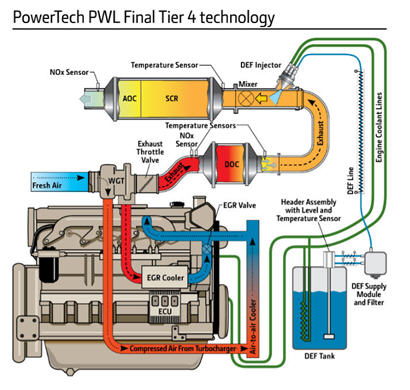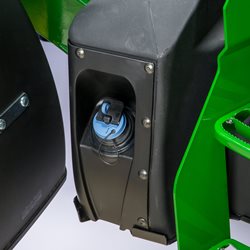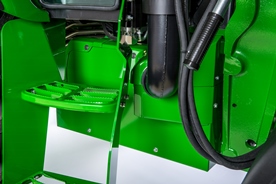The U.S. Environmental Protection Agency and Environment Canada requires all off-road diesel engines with 25 hp or more to meet stringent FT4 emissions regulations. John Deere uses the most efficient and cost-effective solution for the tractor package to meet emissions requirements at each horsepower level. The 5M delivers a hassle-free emissions solution that allows faster work and operation with ease.
The engine powering the 5M is EPA certified Tier Level 4. This is achieved through a combination of a diesel oxidation catalyst (DOC) and selective catalytic reduction (SCR) using diesel exhaust fluid (DEF, or urea).
Several defining features on the 5M maximize the performance and reliability of the emissions package. A completely shielded DOC/SCR not only protects essential components from damage, it also keeps out dirt and debris. The well-packaged and tightly organized circulation system means there is more room to work around the tractor.
 PowerTech PWL Final Tier 4 technology
PowerTech PWL Final Tier 4 technology
Key components of the emissions system include:
DOC
John Deere has chosen to utilize an exhaust filter to reduce particulate material so the engine can operate at a level which produces less NOx. With less NOx created, less DEF is required to treat. The result is improved total fluid economy (diesel and DEF).
The engine is programmed to aggressively respond to changes in power needs, which can temporarily increase particulate matter. Since the exhaust filter removes particulate matter instead of the engine, the engine is left free to do what it is designed to do – deliver all of the power, torque, plus transient response needed.
DEF
DEF is an ISO 22241 standard aqueous urea solution consisting of 32.5 percent urea and has a freezing point of -11°C (12°F). A heated DEF tank keeps the customer in the field longer even when the temperatures drop below freezing. The DEF tank header is integrated with a temperature sensor, and plumbed engine coolant lines are used to promote thawing and prevent freezing in the tank during operation.
 DEF tank
DEF tank
Mounted near the DEF tank, the electronic control unit (ECU)-controlled supply module draws diesel exhaust fluid from the storage tank and provides a pressurized flow to the dosing module. When the ignition key is off, the supply module pump will reverse direction to return any accumulated fluid back to the tank. The supply module is also fitted with a replaceable filter to prevent contaminants from entering the dosing lines. Both the supply module and dosing lines are electrically heated and controlled by the ECU to determine when DEF dosing can begin.
The dosing module is cooled by engine coolant and used to inject DEF at a pressure of 130 psi (900 kPa, 9 bar) into the decomposition tube. A harness is connected to the dosing valve that relays the needed DEF to inject based upon the amount of NOx exiting the DOC measured from the NOx tube sensor.
The decomposition tube is the internal mixing device used to circulate DEF with engine exhaust prior to entering the SCR/AOC after-treatment device.
SCR
To reduce the NOx, DEF is injected into the exhaust stream. When the exhaust gases combine with the DEF in the SCR catalyst, the NOx is broken down into nitrogen and water vapor.
 SCR location on the 5M Tractor
SCR location on the 5M Tractor
Exhaust gas recirculation (EGR)
EGR reduces the high temperatures where these compounds are formed in the engine cylinders by replacing excess oxygen with a prescribed amount of cooled exhaust gas.
Exhaust gases contain more carbon dioxide than oxygen. The EGR valve, in conjunction with the venturi tube, and engine control unit (ECU), allow a controlled amount of exhaust gas to enter the intake manifold to mix with the incoming fresh air.
Replacing excess oxygen with cooled exhaust gas leads to:
- Lower combustion temperatures, creating less NOx.
In addition, EGR allows for:
- Advanced timing
- Optimal engine performance
- Maximum fuel economy
For added performance and efficiency, the engine passes the exhaust gases through an EGR cooler before it enters the engine.
Exhaust airflow enters into the EGR cooler from the exhaust manifold near the turbocharger. Based on engine load, air temperatures, and rpm, the ECU opens or closes the EGR valve, allowing a measured percentage of exhaust gas to enter the intake manifold. The gases mix with the rest of the incoming air from the turbocharger and aftercooler before entering the cylinders.
Series turbochargers
The PowerTech™ PWL 4.5L utilizes one turbocharger — a fixed geometry turbocharger. Fresh air is first drawn into the low-pressure fixed geometry turbocharger and compressed to a higher pressure. The compressed air is then routed to the charge air cooler and then to the intake manifold.
Benefits of air-to-air aftercooling
- Lowers the intake manifold air temperature
- Provides more efficient cooling while reducing temperatures for greater engine reliability
- Higher volume of air flows into the cylinders
- Engine is capable of meeting the increasing horsepower demands
Combustion process with externally cooled EGR
Functions:
- According to engine operating conditions, the recirculated exhaust gases reduce the oxygen portion in the intake air to approximately 20 percent. Without any increase of the charge air pressure, the oxygen rate is not high enough to ensure a complete combustion of the fuel injected at high engine loads.
Advantages:
- Fuel-efficient combustion is achieved, because sufficient oxygen is provided.
A restrained, cooler combustion is realized, since the typical hot combustion process, which is generated by an oxygen surplus, is dampened by the inert exhaust gases. Hence, NOx emissions are reduced.
For more information regarding EPA regulations and the technology behind John Deere Integrated Emissions Control systems, please visit the following link:
http://www.deere.com/wps/dcom/en_US/campaigns/ag_turf/emissions/final_tier_4.page